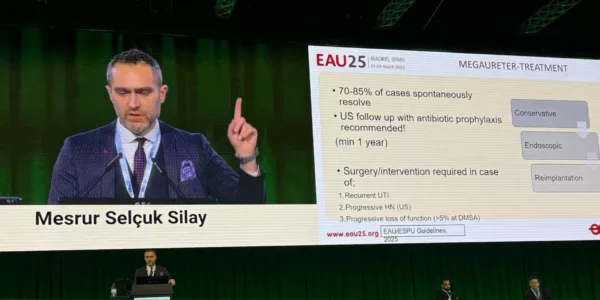Paediatric urology in 2025: Innovation and personalised care
A highly engaging and comprehensive programme on paediatric urology during EAU25 earlier this year showcased significant advancements in the field and its future directions. The EAU Paediatric Urology Working Group (EWPU) created an excellent programme consisting of seven sessions, including two thematic sessions, one video session, two abstract sessions, one expert-guided poster session, and one ESU course. This depth of programming reflected the growing complexity and importance of paediatric considerations in modern urologic practice.
Surgical innovations: From robotics to refined techniques
In the ‘Surgery in Motion’ session, two significant themes emerged. Robotic surgery was prominently featured, particularly in redo-pyeloplasty. The use of robotic technology has notably reduced failure rates due to enhanced visualisation and identification of previously undetected crossing vessels. Similarly, robotic ureteral reimplantation was confirmed as a safe and effective alternative to open surgery, providing comparable outcomes with reduced morbidity. Robotic surgery proposed to be a viable option even in the treatment of primary obstructive megaureter.
In hypospadias surgery, a notable advancement was the “sandwich technique,” a novel approach for severe cases that combines the TIP, Island Flap, and Mathieu techniques. Additionally, the introduction of the double-tube stent was highlighted for its potential to minimise postoperative bladder irritation.
Stone disease: Technology and technique development
Highlights included the validation of 4.9 fr and 7.5 Fr flexible ureteroscopes as safe for paediatric use, along with advances in laser technology, particularly TFL and Moses modes, which have improved fragmentation efficiency, retropulsion control, and surgical outcomes. High-power lithotripsy has delivered shorter operative times and higher stone-free rates without increasing complications. Flexible and navigable suction ureteral access sheaths have been shown to reduce intraoperative injury and achieve 100% stone-free rates. Future directions emphasise even greater miniaturisation, intrarenal pressure monitoring, and less invasive approaches for managing large stone burdens.
ERN-eUROGEN: Collaboration, transition, and shared decision-making
The ERN-eUROGEN session offered a forward-looking perspective with three critical messages. Firstly, it highlighted the importance of centralised care for rare and complex urological diseases. Secondly, it emphasised the need for structured transitions to adult care, which is especially vital for patients with neurogenic bladder, as this could potentially reduce hospitalisations and complications. Lastly, the session stressed the importance of shared decision-making, aligning treatment strategies with patient and family preferences.
Award-winning research and real-world relevance
The Best Abstract focused on a long-term study of catheterisable conduits, which reported 10% stenosis and 25% urine leakage, highlighting the necessity for lifelong and specialised follow-up.
The Best Poster investigated adolescent varicocele, showing no impact on sperm function. Another notable poster proposed Lambert's formula as an accurate method for assessing testicular volume and guiding varicocele surgery.
Thematic insights: Reflux, UTIs, and functional disorders
In a thematic session on vesicoureteral reflux, discussions centred on long-term adult outcomes and the need for tailored management strategies based on a state-of-the-art lecture under the auspices of ESPU. Non-antibiotic UTI treatments using probiotics and antioxidants were also featured as promising conservative options.
Meanwhile, the updated guidelines on neurogenic bladder highlighted the value of multimodal evaluation, and biofeedback therapy was endorsed for managing bowel-bladder dysfunction.
Looking ahead - A unified paediatric urology vision
EAU25 concluded with a clear message: The future of paediatric urology lies in patient-tailored care, multidisciplinary collaboration, and centralised management of rare diseases. These principles were not only echoed throughout the sessions but actively demonstrated through data, innovation, and dialogue.
The paediatric urology community stands poised to continue advancing care through shared knowledge, continuous learning, and patient-focused innovation.
